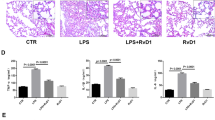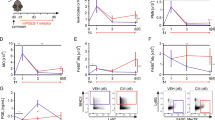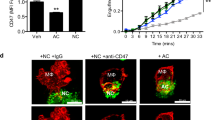Abstract
A growing body of evidence indicates that resolution of acute inflammation is an active process1,2. Resolvins are a new family of lipid mediators enzymatically generated within resolution networks that possess unique and specific functions to orchestrate catabasis, the phase in which disease declines2,3. Resolvin D2 (RvD2) was originally identified in resolving exudates, yet its individual contribution in resolution remained to be elucidated. Here, we establish RvD2’s potent stereoselective actions in reducing excessive neutrophil trafficking to inflammatory loci. RvD2 decreased leukocyte–endothelial interactions in vivo by endothelial-dependent nitric oxide production, and by direct modulation of leukocyte adhesion receptor expression. In mice with microbial sepsis initiated by caecal ligation and puncture, RvD2 sharply decreased both local and systemic bacterial burden, excessive cytokine production and neutrophil recruitment, while increasing peritoneal mononuclear cells and macrophage phagocytosis. These multi-level pro-resolving actions of RvD2 translate to increased survival from sepsis induced by caecal ligation and puncture and surgery. Together, these results identify RvD2 as a potent endogenous regulator of excessive inflammatory responses that acts via multiple cellular targets to stimulate resolution and preserve immune vigilance.
This is a preview of subscription content, access via your institution
Access options
Subscribe to this journal
Receive 51 print issues and online access
$199.00 per year
only $3.90 per issue
Buy this article
- Purchase on Springer Link
- Instant access to full article PDF
Prices may be subject to local taxes which are calculated during checkout




Similar content being viewed by others
References
Gilroy, D. W., Lawrence, T., Perretti, M. & Rossi, A. G. Inflammatory resolution: new opportunities for drug discovery. Nature Rev. Drug Discov. 3, 401–416 (2004)
Serhan, C. N., Chiang, N. & Van Dyke, T. E. Resolving inflammation: dual anti-inflammatory and pro-resolution lipid mediators. Nature Rev. Immunol. 8, 349–361 (2008)
Serhan, C. N. et al. Resolvins: a family of bioactive products of omega-3 fatty acid transformation circuits initiated by aspirin treatment that counter proinflammation signals. J. Exp. Med. 196, 1025–1037 (2002)
Weber, C., Zernecke, A. & Libby, P. The multifaceted contributions of leukocyte subsets to atherosclerosis: lessons from mouse models. Nature Rev. Immunol. 8, 802–815 (2008)
Hotchkiss, R. S. & Karl, I. E. The pathophysiology and treatment of sepsis. N. Engl. J. Med. 348, 138–150 (2003)
Shimizu, T. Lipid mediators in health and disease: enzymes and receptors as therapeutic targets for the regulation of immunity and inflammation. Annu. Rev. Pharmacol. Toxicol. 49, 123–150 (2009)
Hong, S., Gronert, K., Devchand, P. R., Moussignac, R. L. & Serhan, C. N. Novel docosatrienes and 17S-resolvins generated from docosahexaenoic acid in murine brain, human blood, and glial cells. Autacoids in anti-inflammation. J. Biol. Chem. 278, 14677–14687 (2003)
Shimizu, T., Radmark, O. & Samuelsson, B. Enzyme with dual lipoxygenase activities catalyzes leukotriene A4 synthesis from arachidonic acid. Proc. Natl Acad. Sci. USA 81, 689–693 (1984)
Rodriguez, A. R. & Spur, B. W. First total synthesis of 7(S),16(R),17(S)-Resolvin D2, a potent anti-inflammatory lipid mediator. Tetrahedr. Lett. 45, 8717–8720 (2004)
Prescott, S. M., Zimmerman, G. A., Stafforini, D. M. & McIntyre, T. M. Platelet-activating factor and related lipid mediators. Annu. Rev. Biochem. 69, 419–445 (2000)
Cooper, D., Norling, L. V. & Perretti, M. Novel insights into the inhibitory effects of Galectin-1 on neutrophil recruitment under flow. J. Leukoc. Biol. 83, 1459–1466 (2008)
Rittirsch, D. et al. Functional roles for C5a receptors in sepsis. Nature Med. 14, 551–557 (2008)
Kubes, P., Suzuki, M. & Granger, D. N. Nitric oxide: an endogenous modulator of leukocyte adhesion. Proc. Natl Acad. Sci. USA 88, 4651–4655 (1991)
Moncada, S. & Higgs, E. A. The discovery of nitric oxide and its role in vascular biology. Br. J. Pharmacol. 147 (Suppl. 1). S193–S201 (2006)
Bucci, M. et al. Endothelial nitric oxide synthase activation is critical for vascular leakage during acute inflammation in vivo. Proc. Natl Acad. Sci. USA 102, 904–908 (2005)
Paul-Clark, M. J., Van Cao, T., Moradi-Bidhendi, N., Cooper, D. & Gilroy, D. W. 15-epi-lipoxin A4-mediated induction of nitric oxide explains how aspirin inhibits acute inflammation. J. Exp. Med. 200, 69–78 (2004)
Rittirsch, D., Huber-Lang, M. S., Flierl, M. A. & Ward, P. A. Immunodesign of experimental sepsis by cecal ligation and puncture. Nature Protocols 4, 31–36 (2009)
Buras, J. A., Holzmann, B. & Sitkovsky, M. Animal models of sepsis: setting the stage. Nature Rev. Drug Discov. 4, 854–865 (2005)
Singer, P. et al. Anti-inflammatory properties of omega-3 fatty acids in critical illness: novel mechanisms and an integrative perspective. Intensive Care Med. 34, 1580–1592 (2008)
Farolan, L. R., Goto, M., Myers, T. F., Anderson, C. L. & Zeller, W. P. Perinatal nutrition enriched with omega-3 polyunsaturated fatty acids attenuates endotoxic shock in newborn rats. Shock 6, 263–266 (1996)
Pluess, T. T. et al. Intravenous fish oil blunts the physiological response to endotoxin in healthy subjects. Intensive Care Med. 33, 789–797 (2007)
Haworth, R. et al. The macrophage scavenger receptor type A is expressed by activated macrophages and protects the host against lethal endotoxic shock. J. Exp. Med. 186, 1431–1439 (1997)
Litvak, V. et al. Function of C/EBPdelta in a regulatory circuit that discriminates between transient and persistent TLR4-induced signals. Nature Immunol. 10, 437–443 (2009)
Mosser, D. M. & Edwards, J. P. Exploring the full spectrum of macrophage activation. Nature Rev. Immunol. 8, 958–969 (2008)
Flierl, M. A. et al. Adverse functions of IL-17A in experimental sepsis. FASEB J. 22, 2198–2205 (2008)
Souza, D. G. et al. The required role of endogenously produced lipoxin A4 and annexin-1 for the production of IL-10 and inflammatory hyporesponsiveness in mice. J. Immunol. 179, 8533–8543 (2007)
Osuchowski, M. F., Welch, K., Siddiqui, J. & Remick, D. G. Circulating cytokine/inhibitor profiles reshape the understanding of the SIRS/CARS continuum in sepsis and predict mortality. J. Immunol. 177, 1967–1974 (2006)
Huang, X. et al. PD-1 expression by macrophages plays a pathologic role in altering microbial clearance and the innate inflammatory response to sepsis. Proc. Natl Acad. Sci. USA 106, 6303–6308 (2009)
Dombrovskiy, V. Y., Martin, A. A., Sunderram, J. & Paz, H. L. Rapid increase in hospitalization and mortality rates for severe sepsis in the United States: a trend analysis from 1993 to 2003. Crit. Care Med. 35, 1244–1250 (2007)
Chatterjee, B. E. et al. Annexin 1-deficient neutrophils exhibit enhanced transmigration in vivo and increased responsiveness in vitro. J. Leukoc. Biol. 78, 639–646 (2005)
Serhan, C. N., Lu, Y., Hong, S. & Yang, R. Mediator lipidomics: search algorithms for eicosanoids, resolvins, and protectins. Methods Enzymol. 432, 275–317 (2007)
Takano, T., Clish, C. B., Gronert, K., Petasis, N. & Serhan, C. N. Neutrophil-mediated changes in vascular permeability are inhibited by topical application of aspirin-triggered 15-epi-lipoxin A4 and novel lipoxin B4 stable analogues. J. Clin. Invest. 101, 819–826 (1998)
Acknowledgements
We acknowledge support from National Institutes of Health grants GM-38765 and P50-DE016191 (C.N.S.), Welcome Trust Programme grant 086867/Z/08/Z (R.J.F. and M.P.) and Project grant 085903/Z/08 (R.J.F.) and Arthritis Research Campaign UK fellowships 18445 and 18103 (to L.V.N. and D.C., respectively). M.S. received a National Research Service Award from the NHLBI (HL087526). We thank J. W. Winkler and J. Uddin for work related to RvD2 synthesis, P. Pillai, K. Martinod, G. Fredman and J. Dalli for technical assistance, and M. H. Small for assistance with the manuscript. We also thank B. Schmidt for histopathology, Children’s Hospital Boston.
Author Contributions M.S. and L.V.N. designed and carried out experiments, analysed data and wrote the manuscript; L.S., R.Y. and D.C. carried out experiments and analysed data; N.A.P. synthesized RvD2; R.J.F. and M.P. designed experiments, analysed data and contributed to the manuscript; C.N.S. planned the project, designed experiments, analysed data and wrote the manuscript.
Author information
Authors and Affiliations
Corresponding author
Ethics declarations
Competing interests
[Competing Interests: The resolvins are biotemplates for stable analogues. Patents on these are awarded and assigned to Brigham and Women’s Hospital, C.N.S. is inventor. These analogue patents are licensed for clinical development.]
Supplementary information
Supplementary Information
This file contains Supplementary Figures 1-11 with Legends, Supplementary Methods and Supplementary References. (PDF 4216 kb)
Supplementary Movie 1
This file shows a time-lapse movie (approximately 1 min at double-speed) of leukocyte adhesion to a post-capillary venule, and emigration into the surrounding tissue following 1h of PAF (1 nM) superfusion. (MOV 3218 kb)
Supplementary Movie 2
This file shows a time-lapse movie (approximately 1 min at double-speed) of decreased leukocyte adhesion to a post-capillary venule, and emigration into the surrounding tissue following 2h of PAF (1 nM) plus 1h of RvD2 (1 nM) superfusion. (MOV 3289 kb)
Supplementary Movie 3
This file shows the remarkable difference in behaviour of vehicle (red) or RvD2 (100 ng i.v.; blue) treated mice 12h after CLP-induced sepsis. (MOV 5050 kb)
Rights and permissions
About this article
Cite this article
Spite, M., Norling, L., Summers, L. et al. Resolvin D2 is a potent regulator of leukocytes and controls microbial sepsis. Nature 461, 1287–1291 (2009). https://doi.org/10.1038/nature08541
Received:
Accepted:
Issue Date:
DOI: https://doi.org/10.1038/nature08541
This article is cited by
-
Nanoparticles Treat Ischemic Stroke by Responding to Stroke Microenvironment
BioNanoScience (2024)
-
Interface between Resolvins and Efferocytosis in Health and Disease
Cell Biochemistry and Biophysics (2024)
-
Eicosanoids Signals in SARS-CoV-2 Infection: A Foe or Friend
Molecular Biotechnology (2023)
-
N-Oleoyl dopamine induces IL-10 via central nervous system TRPV1 and improves endotoxemia and sepsis outcomes
Journal of Neuroinflammation (2022)
-
m6A demethylase ALKBH5 is required for antibacterial innate defense by intrinsic motivation of neutrophil migration
Signal Transduction and Targeted Therapy (2022)
Comments
By submitting a comment you agree to abide by our Terms and Community Guidelines. If you find something abusive or that does not comply with our terms or guidelines please flag it as inappropriate.



